- Techniques
- Strikes
Taekwondo 태권도Taekwondo Preschool
When you reach senior belt you are expected to guide the junior belts when they are beginning Taekwondo such as showing by example. To advance from one rank to the next, students typically complete promotion tests in which they demonstrate their proficiency in the various aspects of the art before a panel of judges or their teacher. View Taekwondo belt levels »

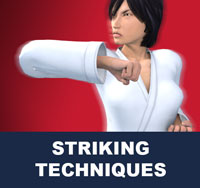


Taekwondo Strikes
Physically, taekwondo develops strength, speed, balance, flexibility, and stamina. An example of the union of mental and physical discipline is the breaking of wooden boards, bricks or tiles, which requires both physical mastery of the technique and the concentration to focus one's power.
Taekwondo hand strikes are performed as a close distance alternative to kicks ( 차기 chagi ). They are executed in a number of ways - from standing, jumping, spinning and rushing forwards. Hand strikes make up fast combinations of strikes which can leave an opponent stunned and unable to defend himself most commonly in self defense ( 호신술 hosinsool ) applications. Muscles should only be tensed at the moment of imaginary impact in order to commute maximum power to any individual taekwondo technique. Taekwondo hand strikes can be separated into various distinct styles:
- Fist Strikes ( 지르기 jireugi ) - techniques striking with the fist ( 주먹 jumeok ) in a punching motion
- Strikes ( 치기 chigi ) - techniques done with the twisting force of the body excluding techniques using the fist ( 주먹 jumeok ) for punches or the fingertips ( 손끝 sonkkeut )
- Chopping ( 찍기 jjikgi ) - techniques striking with curled fingertips ( 모둠손끝 modumsonkkeut )
- Thrusting ( 찌르기 jjireugi ) - techniques striking with fingertips ( 손끝 sonkkeut )
- Horizontal Thrust ( 엎어찌르기 eopeo-jjireugi ) - thrusting horizontally with the fingertips ( 손끝 sonkkeut )
- Vertical Thrust ( 세워찌르기 sewo-jjireugi ) - thrusting vertically with the fingertips ( 손끝 sonkkeut )
Variations of Strikes
- Outward Strike ( 바깥치기 bakkat-chigi )
- Turning Strike ( 돌려치기 dollyeo-chigi )
- Inward Strike ( 안치기 an-chigi )
- Twisting Strike ( 비틀어치기 bitureo-chigi )
- Downward Strike ( 내려치기 naeryeo-chigi )
- Forward Strike ( 앞치기 ap-chigi )
- Side Strike ( 옆치기 yeop-chigi )
- Upward Strike ( 올려치기 olgul-chigi )
- Target Strike ( 표적치기 pyojeok-chigi )
- Supporting Strike ( 거들어치기 kodureo-chigi )
- Pulling Strike ( 당겨치기 danggyeo-chigi )
Various surfaces of the hand ( 손 son ) may be engaged as the striking surface depending on which area of the opponents body is being targeted. This leads to a large array of hand positions and taekwondo also makes use of reverse and front elbow strikes ( 팔굽 치기 palgup-chigi ).
Strikes
Technique Injuries
Collisions with the ground, objects, and other taekwondo practitioners are common, and unexpected dynamic forces on limbs and joints can cause injury. Taekwondo injuries can also occur in techniques if done improperly or from overuse of a particular body part. Taking a break from training or reducing the volume and the intensity of the training will allow the body to recover. For more information on Injuries »
( Click image for additional information)
* Please see a certified Master Instructor ( 사범님 sabeomnim ) for training. Proper guidance and instructions are needed to ensure safe training.
Advertisement
TAEKWONDO STRIKES |
|||||
| Hangul 한글 | Korean | Belt Requirement | Difficulty Level | Tutorial | |
| Fist Punch | ( 주먹 지르기 ) | jumeok-jireugi |   |
Beginner Level | Tutorial » |
| Middle Punch | ( 몸통 지르기 ) | momtong-jireugi |   |
Beginner Level | Tutorial » |
| Front Hand Middle Punch | ( 몸통 반대 지르기 ) | momtong-bandae-jireugi |   |
Beginner Level | Tutorial » |
| Low Punch | ( 아래 지르기 ) | arae-jireugi |   |
Beginner Level | |
| High Punch | ( 올려 지르기 ) | olgul-jireugi |   |
Beginner Level | Tutorial » |
| Rear Hand Middle Punch | ( 몸통 바로 지르기 ) | momtong-baro-jireugi |   |
Beginner Level | Tutorial » |
| Double Punch | ( 몸통 두번 지르기 ) | dubeon-jireugi |   |
Beginner Level | |
| Knife Hand Inward Strike | ( 손날 안치기 ) | sonnal-an-chigi |   |
Intermediate Level | Tutorial » |
| Lift Punch | ( 치지르기 ) | chi-jireugi |   |
Intermediate Level | Tutorial » |
| Back Knuckle Forward Strike | ( 등주먹 앞치기 ) | deung-jumeok-ap-chigi |   |
Intermediate Level | Tutorial » |
| Downward Punch | ( 내려지르기 ) | naeryeo-jireugi |   |
Intermediate Level | Tutorial » |
| Swallow Hand Blade Inward Strike | ( 제비품 손날 안치기 ) | jebipoom-sonnal-an-chigi |   |
Intermediate Level | Tutorial » |
| Spearhand Vertical Thrust | ( 편손끝 세워찌르기 ) | pyeonsonkkeut-sewo-jjireugi |    |
Intermediate Level | Tutorial » |
| Supporting Vertical Thrust | ( 거들어 세워찌르기 ) | kodureo-sewo-jjireugi |    |
Intermediate Level | Tutorial » |
| Elbow Turning Strike | ( 팔굽 돌려치기 ) | palgup-dollyeo-chigi |   |
Intermediate Level | Tutorial » |
| Elbow Target Strike | ( 팔굽 표적치기 ) | palgup-pyojeok-chigi |   |
Intermediate Level | Tutorial » |
| Hammer Fist Strike | ( 메주먹 치기 ) | mejumeok-chigi |   |
Intermediate Level | |
| Hammer Fist Downward Strike | ( 메주먹 내려치기 ) | mejumeok-naeryeo-chigi |   |
Intermediate Level | Tutorial » |
| Hammer Fist Outward Strike | ( 메주먹 바깥치기 ) | mejumeok-bakkat-chigi |   |
Intermediate Level | Tutorial » |
| Vertical Punch | ( 세워지르기 ) | sewo-jireugi |  |
Intermediate Level | Tutorial » |
| Turning Punch | ( 돌려지르기 ) | dollyeo-jireugi |  |
Intermediate Level | Tutorial » |
| Outward Back Fist | ( 등주먹 바깥치기 ) | deung-jumeok-bakkat-chigi |   |
Intermediate Level | Tutorial » |
| Hand Blade Outward Strike | ( 손날 바깥치기 ) | sonnal-olgul-bakkat-chigi |   |
Intermediate Level | Tutorial » |
| Hand Blade Side Strike | ( 손날 옆치기 ) | sonnal-yeop-chigi |   |
Intermediate Level | Tutorial » |
| Elbow Rear Strike | ( 팔굽 뒤치기 ) | palgup-dwi-chigi |   |
Intermediate Level | Tutorial » |
| Elbow Downward Strike | ( 팔굽 내려치기 ) | palgup-naeryeo-chigi |   |
Intermediate Level | Tutorial » |
| Side Punch | ( 옆지르기 ) | yeop-jireugi |   |
Advanced Level | Tutorial » |
| Turn Over Punch | ( 젖혀지르기 ) | jeocheo-jireugi |   |
Advanced Level | Tutorial » |
| (Fist) Turn-over Punch | ( (주먹) 젖혀지르기 ) | (jumeok) jeocheo-jireugi |   |
Advanced Level | |
| (Double-Fist) Turn-over Punch | ( (두주먹) 젖혀지르기 ) | (dujumeok) jeocheo-jireugi |   |
Advanced Level | |
| Downward Chop | ( 내려찍기 ) | naeryeo-chigi |   |
Advanced Level | |
| Inward Chop | ( 안찍기 ) | an-chigi |   |
Advanced Level | |
| Forward Chop | ( 앞찍기 ) | ap-chigi |   |
Advanced Level | |
| 'C' Shape Punch | ( ‘ㄷ’ 자지르기 ) | digeutja-jireugi |   |
Advanced Level | Tutorial » |
| Pulling and Punching | ( 당겨지르기 ) | danggyeo-jireugi |   |
Advanced Level | Tutorial » |
| Target Punch | ( 표적지르기 ) | pyojeok-jireugi |   |
Advanced Level | Tutorial » |
| Palm Heel Forward Strike | ( 바탕손 앞치기 ) | batangson-ap-chigi |   |
Advanced Level | Tutorial » |
| Swallow Palm Heel Front Strike | ( 제비품 바탕손 앞치기 ) | jebipoom-batangson-ap-chigi |   |
Advanced Level | Tutorial » |
| Extended Knuckle Fist | ( 밤주먹 지르기 ) | bamjumeok-jireugi |   |
Advanced Level | Tutorial » |
| Extended Knuckle Fist Turn-over Punch | ( 밤주먹 젖혀지르기 ) | bamjumeok-jeocheo-jireugi |   |
Advanced Level | |
| Bent Wrist Upward Strike | ( 굽힌손목 올려치기 ) | gupinsonmok-ollyeo-chigi |  |
Advanced Level | Tutorial » |
| Pincer Hand Strike | ( 집게주먹 지르기 ) | jipge-jumeok-jireugi |  |
Advanced Level | Tutorial » |
| Scissors Fingertip Thrust | ( 가위손끝 찌르기 ) | gawisonkkeut-jjireugi |  |
Advanced Level | Tutorial » |
| Flat Fingertips Horizontal Strike | ( 편손끝 엎어찌르기 ) | pyeonsonkkeut-eopeo-jjireugi |  |
Advanced Level | Tutorial » |
| Ridgehand Inward Strike | ( 손날등 안치기 ) | sonnal-deung-an-chigi |  |
Advanced Level | Tutorial » |
| Ridgehand Downward Strike | ( 손날등 내려치기 ) | sonnal-deung-naeryeo-chigi |  |
Advanced Level | Tutorial » |
| Fork Punch | ( 쳇다리지르기 ) | chetdar-jireugi |  |
Advanced Level | Tutorial » |
| Keumgang Punch | ( 금강지르기 ) | keumgang-jireugi |  |
Advanced Level | Tutorial » |
| Keumgang Forward Punch | ( 금강 앞지르기 ) | keumgang-ap-jireugi |  |
Advanced Level | |
| Keumgang Side Punch | ( 금강 옆지르기 ) | keumgang-yeop-jireugi |  |
Advanced Level | |


Related Articles
Taekwondo hand strikes are performed as a close distance alternative to kicks ( 차기 chagi ). Various surfaces of the hand may be engaged as the striking surface depending on which area of the opponents body is being targeted. This leads to a large array of hand positions. They are executed in a number of ways - from standing, jumping, spinning and rushing forwards. Hand strikes make up fast combinations of strikes which can leave an opponent stunned and unable to defend himself. Taekwondo also makes use of reverse, front and downward elbow strikes. View Taekwondo Strikes »

Quiz
Question. What is the korean terminology for Attention Stance?
Attention is a stance ( 서기 sogi ) where your body is in an upright standing position with the legs side by side, heels touching, distribute 50/50 weight ratio on the left and right legs, and toes facing straight forward. Your hands should be parallel with your body, to the side as your hands tap the legs.
What is the korean terminology for Attention Stance?
Answer you gave was: ( 그만 keu-man )
Your answer is wrong! You need to study more!
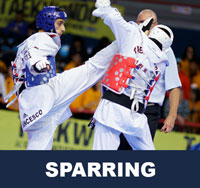

Keu-man ( 그만 ) means to stop a sparring match or poomse. Sparring is a full-contact event and takes place between two competitors in an area measuring 8 meters square. A poomse or form is a detailed pattern of defense-and-attack motions and techniques used in traditional martial arts. Poomse is the foundation for the teaching of taekwondo.
View Korean Terminology »
What is the korean terminology for Attention Stance?
Answer you gave was: ( 차렷 charyeot )
Your answer is correct! Great Job!
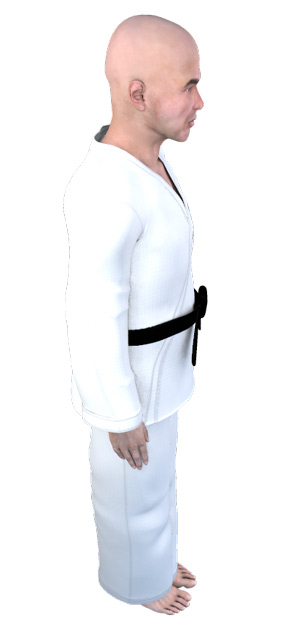

Attention is a stance where your body is in an upright standing position with the legs side by side, heels touching, toes facing straight forward. From this stance instructors explain what will be taught during the class session and/or if they want your attention they say Charyeot, meaning you stop whatever you are doing and get into the stance awaiting further instructions. This is the stance ( 서기 sogi ) that all bows ( 경례 gyeong-nye ) come from and is one of the most basic techniques to learn when starting taekwondo as a beginner.
What is the korean terminology for Attention Stance?
Answer you gave was: ( 기합 kihap )
Your answer is wrong! You need to study more!
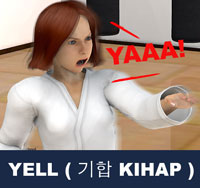

Kihap 기합 is a korean term used in taekwondo which is commonly referred to as a shout or yell made before, during, or after a technique. There are numerous examples of this battle cry in other martial arts: kihap is perhaps primarily a development of this. Students also use kihap to startle an opponent, intimidate, express confidence, or express victory in sparring competitions, self-defense ( 호신술 hosinsool ), or breaking ( 격파 gyeokpa ) applications.
View Yell ( 기합 kihap ) »
What is the korean terminology for Attention Stance?
Answer you gave was: ( 경례 gyeong-nye )
Your answer is wrong! You need to study more!
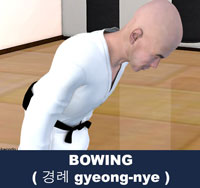

Bowing ( 경례 gyeong-nye ) is the act of lowering the torso and head as a gesture in direction to another person (Master Instructor 사범님 sabeomnim ) or symbol (flag). Bowing is an integral part of traditional martial arts such as Taekwondo. Bows are used to begin and end practice, sparring bouts and competitions, and when entering and leaving the dojang, or practice room.
Question. What year was Taekwondo an official Olympic Demonstration Sport in Seoul, Korea?
Taekwondo made its first appearance at the Summer Olympic Games as a demonstration sport at the Summer Olympics in Seoul, South Korea. The opening ceremony featured a mass demonstration of taekwondo with hundreds of adults and children performing moves in unison. Taekwondo was again a demonstration sport at the Summer Olympics in Barcelona, Spain. There were no demonstration sports at the Summer Olympics in Atlanta, USA.
What year was Taekwondo an official Olympic Demonstration Sport in Seoul, Korea?
Answer you gave was: 1992
Your answer is wrong! You need to study more!


In 1982, taekwondo was designated an official demonstration sport for the 1988 Olympic Games in Seoul, Korea, and for the 1992 Olympic Games in Barcelona, Spain. Taekwondo made its first appearance at the Summer Olympic Games as a demonstration sport at the 1988 Summer Olympics in Seoul, South Korea. The opening ceremony featured a mass demonstration of taekwondo with hundreds of adults and children performing moves in unison.
View Olympic Games »
What year was Taekwondo an official Olympic Demonstration Sport in Seoul, Korea?
Answer you gave was: 1988
Your answer is correct! Great Job!


In 1982, taekwondo was designated an official demonstration sport for the 1988 Olympic Games in Seoul, Korea, and for the 1992 Olympic Games in Barcelona, Spain. Taekwondo made its first appearance at the Summer Olympic Games as a demonstration sport at the 1988 Summer Olympics in Seoul, South Korea. The opening ceremony featured a mass demonstration of taekwondo with hundreds of adults and children performing moves in unison.
View Olympic Games »
What year was Taekwondo an official Olympic Demonstration Sport in Seoul, Korea?
Answer you gave was: 2000
Your answer is wrong! You need to study more!


In 1982, taekwondo was designated an official demonstration sport for the 1988 Olympic Games in Seoul, Korea, and for the 1992 Olympic Games in Barcelona, Spain. Taekwondo made its first appearance at the Summer Olympic Games as a demonstration sport at the 1988 Summer Olympics in Seoul, South Korea. The opening ceremony featured a mass demonstration of taekwondo with hundreds of adults and children performing moves in unison.
View Olympic Games »
What year was Taekwondo an official Olympic Demonstration Sport in Seoul, Korea?
Answer you gave was: 1996
Your answer is wrong! You need to study more!


In 1982, taekwondo was designated an official demonstration sport for the 1988 Olympic Games in Seoul, Korea, and for the 1992 Olympic Games in Barcelona, Spain. Taekwondo made its first appearance at the Summer Olympic Games as a demonstration sport at the 1988 Summer Olympics in Seoul, South Korea. The opening ceremony featured a mass demonstration of taekwondo with hundreds of adults and children performing moves in unison.
View Olympic Games »
Question. What is the korean terminology for Low Block?
The Low Block is one of the most basic Taekwondo blocks ( 막기 makgi ) and one of the first things a beginner will learn. The lead forearm is bent and raised to shoulder height, snapping the arm straight down with the palm ( 손바닥 sonbadak ) facing the ground, which blocks any incoming low kicks ( 차기 chagi ) or low strikes.
Question. What is the korean terminology for Low Block?
Answer you gave was: ( 아래막기 arae-makgi )
Your answer is correct! Great Job!

The Low Block ( 아래막기 arae-makgi ) is one of the most basic Taekwondo blocks ( 막기 makgi ) and one of the first things a beginner will learn. The lead forearm is bent and raised to shoulder height, snapping the arm straight down with the palm ( 손바닥 sonbadak ) facing the ground, which blocks any incoming low kicks ( 차기 chagi ) or low strikes.
Question. What is the korean terminology for Low Block?
Answer you gave was: ( 바깥막기 momtong bakkat makgi )
Your answer is wrong! You need to study more!

An Outside Middle Block ( 바깥막기 momtong-bakkat-makgi ) deflects a strike away from the defender leaving an opportunity for a counterattack. For example, against a straight punch ( 지르기 jireugi ) to the chest area, an Outside Middle Block ( 바깥막기 momtong-bakkat-makgi ) would aim to meet the forearm of the attacker, pushing the punch ( 지르기 jireugi ) outwards causing it to miss, and then most commonly leaving the defender slightly to the side to counterattack the opponent.
Question. What is the korean terminology for Low Block?
Answer you gave was: ( 몸통막기 momtong makgi )
Your answer is wrong! You need to study more!

An inside Middle Block ( 몸통막기 momtong-makgi ) deflects a strike away from the defender and away from the attacker. For example, against a straight punch ( 지르기 jireugi ) to the face, an inside forearm block would aim to meet the inside of the forearm of the attacker, pushing the punch ( 지르기 jireugi ) outward, leaving the opponent open for a counter attack.
Question. What is the korean terminology for Low Block?
Answer you gave was: ( 올려막기 olgul makgi )
Your answer is wrong! You need to study more!

The High Block ( 올려막기 olgul-makgi ) deflects a downward strike such as a Hammer Fist Downward Strike ( 메주먹 내려치기 mejumeok-naeryeo-chigi ), a stick attack from above, a face punch from a taller opponent, or possibly a kick like the Axe Kick ( 내려차기 naeryeo-chagi ). The blocking arm starts low with the hand in a relaxed fist ( 주먹 jumeok ) across the abdomen (over the belt) with the palm ( 손바닥 sonbadak ) facing upward.
Question. What is the korean terminology for Walking Stance?
The Walking Stance is a beginner stance ( 서기 sogi ) that is used to approach or retreat in combat and poomse. Feet should be maintained approximately 3 foot-length from origin. To maintain a solid base, the front foot is facing straight forward and the back foot is 30 degrees to aid balance.
Question. What is the korean terminology for Walking Stance?
Answer you gave was: ( 주춤서기 juchum sogi )
Your answer is wrong! You need to study more!

The Horse-Riding Stance ( 주춤서기 juchum-sogi ) is a beginner stance ( 서기 sogi ) generally used to practice punches ( 지르기 jireugi ) and blocks ( 막기 makgi ). It is similar to the Ready Stance ( 기본준비 junbi ) but the feet are placed much wider, about two-foot length's apart. Also, the knees ( 무릎 mureup ) are deeply bent and the shins ( 정강이 jeonggangi ) should be kept slightly perpendicular to the floor.
Question. What is the korean terminology for Walking Stance?
Answer you gave was: ( 기본준비 junbi )
Your answer is wrong! You need to study more!

Ready Stance ( 기본준비 junbi ) is performed by standing with the feet one foot-length from origin apart, measured from the inside edge or namely the Reverse Foot Blade ( 발날등 balnaldeung ) of the feet. The arms are slightly bent and the fists held tightly about one fist size apart just below the belly button and the fists should be a fist size away from the body. The stance ( 서기 sogi ) is one of the most important techniques to learn when starting taekwondo as a beginner.
Question. What is the korean terminology for Walking Stance?
Answer you gave was: ( 앞굽이 ap kubi )
Your answer is wrong! You need to study more!

Front Stance ( 앞굽이 ap-kubi ) is one of the most important techniques to learn when starting taekwondo as a beginner. The distance between the inside edges or namely the Reverse Foot Blade ( 발날등 balnaldeung ) of both feet should be between one to two fists apart and is about 4 to 4 one-half foot-length from origin. Rear toes are turned outward about 30 degrees and the body is also naturally angled at 30 degrees or facing straight forward depending on the upper body technique.
Question. What is the korean terminology for Walking Stance?
Answer you gave was: ( 앞서기 ap sogi )
Your answer is correct! Great Job!

The Walking Stance ( 앞서기 ap-sogi ) is a beginner stance ( 서기 sogi ) that is used to approach or retreat in combat and patterns ( 품새 poomse ). Feet should be maintained approximately 3 foot-length from origin. To maintain a solid base, the front foot is facing straight forward and the back foot is 30 degrees to aid balance. Use of this stance ( 서기 sogi ) is featured prominently in many of the World Taekwondo (WT) Poomse.
Risk of injury can be reduced by completing an effective warm up consisting of a heart raiser to get your pulse up, followed by sport specific dynamic stretches (stretches whilst moving). Please follow the guidance of a certified Master Instructor or trainer when doing sports related activities. Depending on the intensity of the exercise, cooling down can involve a slow jog or walk, or with lower intensities, stretching can be used. Cooling down allows the heart rate to return to its resting rate. View more information on Warming Up and Cooling Down ».
This article uses material from the Wikipedia articles "Warming Up" and "Cooling Down", which is released under the Creative Commons Attribution-Share-Alike License 3.0.
RESOURCES
This article uses material from the Wikipedia article "List of Taekwondo Techniques", which is released under the Creative Commons Attribution-Share-Alike License 3.0.








